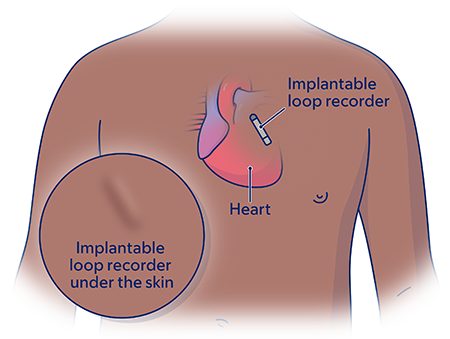
This information explains what an implantable loop recorder (ILR) is and why you may need one. It also explains the procedure to place an ILR and what to expect while you have one.
An ILR is also called an insertable cardiac monitor (ICM).
An ILR is a device that measures and records your heartbeat. It’s placed under your skin on your chest, near your heart (see Figure 1).

Your ILR will measure your heartbeat all the time while it’s in place. If your heart rate gets too fast or too slow, it will automatically start recording your heartbeats. The recording will be wirelessly sent to your care team.
You can also use an app on your smartphone to tell your ILR when to start recording. Your care team will give you more information about using the app.
An ILR can measure and record your heartbeat for 3 to 5 years. Once you don’t need it anymore, you can choose to leave it in place or have it taken out.
You may need an ILR if you have problems with:
Before you get an ILR, your healthcare provider will do other tests to check your heart. If those tests can’t explain your health issue, they may recommend getting an ILR. This is because an ILR can measure your heartbeat all the time for up to 5 years. Other tests only measure your heartbeat for up to 30 days at a time.
Your healthcare provider will use the recordings from your ILR to see if your heart is causing your health issues. Once they know the cause, they can plan the best way to treat it.
Your healthcare provider will talk with you about the risks and benefits of getting an ILR. Your risks will depend on things such as your age and your other medical conditions. Most people have their ILR placed without any problems.
You must have a responsible care partner take you home after your procedure. A responsible care partner is someone who can help you get home safely. They should be able to contact your care team if they have any concerns. Make sure to plan this before the day of your procedure.
If you don’t have a responsible care partner to take you home, call one of the agencies below. They’ll send someone to go home with you. There’s a charge for this service, and you’ll need to provide transportation. It’s OK to use a taxi or car service, but you still need a responsible care partner with you.
| Agencies in New York | Agencies in New Jersey |
| VNS Health: 888-735-8913 | Caring People: 877-227-4649 |
| Caring People: 877-227-4649 |
You may need to avoid eating or drinking anything for 4 hours before your procedure. Follow your healthcare provider’s instructions.
Your healthcare provider will tell you which medications to take before your procedure. Follow their instructions. Do not stop taking any medications unless your healthcare provider tells you to do so.
First, your healthcare provider will give you an injection (shot) of a local anesthetic (A-nes-THEH-tik). A local anesthetic is a medication that numbs an area of your body.
Once the area is numb, your healthcare provider will make a small incision (cut) in your skin. For most people, the incision is on the left upper chest. They’ll make a small space for the ILR under your skin and place the ILR there. Then, they’ll close the incision with sutures (stitches) or Dermabond ® (surgical glue). They’ll put a small bandage over the incision.
The procedure to get your ILR will take about 30 to 60 minutes.
Your healthcare provider will ask you if you have any pain. If you do, they will give you medication to help manage it. You can also take an over-the-counter pain medication (pain medication you buy without a prescription). Your healthcare provider will give you more specific instructions if you need them.
You will be able to go home the same day as your procedure. You will need a responsible care partner to take you home.
Call your healthcare provider if:
If you have questions or concerns, contact your healthcare provider. A member of your care team will answer Monday through Friday from 9 a.m. to 5 p.m. Outside those hours, you can leave a message or talk with another MSK provider. There is always a doctor or nurse on call. If you’re not sure how to reach your healthcare provider, call .
If you have questions or concerns, contact your healthcare provider. A member of your care team will answer Monday through Friday from 9 a.m. to 5 p.m. Outside those hours, you can leave a message or talk with another MSK provider. There is always a doctor or nurse on call. If you’re not sure how to reach your healthcare provider, call .
For more resources, visit www.mskcc.org/pe to search our virtual library.
About Your Implantable Loop Recorder - Last updated on May 5, 2023
All rights owned and reserved by Memorial Sloan Kettering Cancer Center